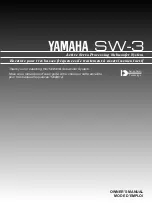
pointing upwards and the microphone top
at the height of the engineer’s ear. The
microphone is a part of the GLM User Kit.
• Connect the microphone cable to the
microphone input in the GLM Adapter
device.
• Download the GLM software at the
Genelec web site (www.genelec.com).
• Install the GLM software and follow the
instructions in the software to measure
and set up your system.
• If you plan to not use a computer for
controlling the monitors, use the GLM
software to write the setting into the
monitors (use menu item “Store | Store
the Current Group Settings…”).
While the GLM network is disconnected
the settings stored using the Genelec
Loudspeaker Manager software can be can
be retrieved and activated by setting the
STORED switch ON.
With GLM active and controlling the
subwoofer, the use of analogue or digital
inputs is forced by the “Input Type” in the
Group.
In standalone manual mode, AES/EBU
digital signal will override analogue signal if
valid digital clock is detected.
Using standalone Stored Settings, the
input type defined by the Group is used.
Use Without GLM
Cabling
The 7300 series subwoofers can be easily set
up using the fixed 85 Hz analogue crossover
filter. This fixed crossover filter is on as
a factory setting and highpass filters the
analogue outputs on the subwoofer. When
using this method, run each signal cable first
to the subwoofer. Then, run the respective
output to the monitor. This monitor feed
signal is highpass filtered at 85 Hz.
When using an analogue LFE signal, run
the LFE signal to the subwoofer's LFE IN
connector.
Control Switches
BASS ROLL-OFF controls compensate for
the very low frequency boost, reducing the
20 Hz level in 4 dB steps. The settings add
to a total of 12 dB attenuation. Setting both
switches to "OFF" obtains a flat response.
PHASE switches can put the subwoofer
in phase with a selected main monitor.
Incorrect phase alignment can cause a drop
in level at the crossover frequency. See
chapter "Setting the Phase Switches."
Digital LFE switch activates LFE processing
for the "AES/EBU DIGITAL IN" input and sets
the low pass frequency for the subframe
selected to reproduce the LFE channel to
150 Hz (see also "LFE CHANNEL" below).
LFE CHANNEL A/B selects which
subframe in the "AES/EBU DIGITAL IN"
input carries the LFE channel. "ON" for A,
"OFF" for B. If A is selected for LFE, the B
subframe is assumed to carry main channel
audio and vice versa.
LFE +10 dB function adds +10 dB of gain.
See chapter "Using the LFE +10 dB function."
LEVEL switches scale down the subwoofer
output level. The switch settings add up and
combine with the rotary level adjustment
control.
TEST TONE switch activates the 85 Hz test
tone used for calibrating the phase. See
chapter "Manual Phase Adjustment Method""
ISS switch activates the signal sensing
automatic energy saving function.
STORED switch selects the settings
stored inside the memory of the subwoofer
and settings made by the subwoofer's
controls. The stored settings are set using
the GLM Loudspeaker Manager Software
and the GLM control network and provide
superior functionality compared to the
subwoofer's own controls.
Connector Panel Light
Normally, the light on the connector panel is
green, indicating normal operational mode.
Red colour indicates amplifier clipping and
yellow indicates thermal overload. If the red
or yellow warning light appears, turn down
the level.
Setting the Phase Switches
Incorrect phase alignment between main
monitors and subwoofer causes a drop
in the frequency response of the whole
system at the crossover frequency. Figure 3
shows the effect of phase difference to the
frequency response.
The phase difference between the main
monitors and subwoofer at the listening
position depends on the position of the
subwoofer, so the phase adjustment should
be done only after the preferred position is
found and subwoofer and monitor levels
have been aligned. GLM software control
Figure 3. The effect of phase difference between the subwoofer and the main monitors
Phase Difference: 0°
85 Hz
Phase Difference: 180°
85 Hz
Phase Difference: 270°
85 Hz
Phase Difference: 90°
85 Hz


























